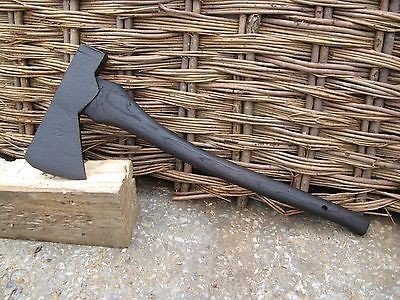outofthefire
Member
- Messages
- 2,881
I replaced the fibre glass shafts on our mauls with bits of pipe off forestry machines. Was concerned that you might get more vibration in your hands but it’s fine.
 If it ever breaks it will get some pipe welded in and a piece of rubber hose for a handle cover but now I have a hydraulic splitter it doesn't see much action.
If it ever breaks it will get some pipe welded in and a piece of rubber hose for a handle cover but now I have a hydraulic splitter it doesn't see much action.Could be, but we also make coopers hammers and hoop drivers, the hoop driver surprised me the most because i'd have thought that would have been curved.
View attachment 262339 View attachment 262340
I miss the part where once fitted on the handle and driven into the head it will not expand or Allow the handle to expand into the head so I can't understand how the fit those reinforcement collars on the handle .Sorry, you know as much as I do.
There might be a video somewhere showing them being made...
I'll have a look anyway.
Sleeve on the head first?The sleeve slides on first then the head is fitted then the wedges stop it all coming off.
Sleeve on the head first?
Or on the handle first?

Not sure if I'll be able to drive the wedges in to it .
I rely on the heat/press fitI cut a slot in mine with a tenon saw before I fit the head then drive the wooden wedge into the slot and a metal cleat in the other direction to hold it in place.
I rely on the heat/press fit
A single wedge should be able fine , double better
It didn't smoke and the wood was clean under it just little bit brownishI would be wary of using such a process at such a critical junction. The science is not exactly definite on the subject though I'm sure if done properly it must work but get it slightly wrong and it will weaken the wood.
"The ignition temperature of wood is affected by how long itis exposed to heat. Woodusually ignites at 250 – 300 C. After ignition, the wood begins to carbonise at a rate of 0.8 mm per minute."
Yellow tempering oxidation colours occurs between 210-250C. "The thermal softening of dry wood begins at a temperature of about 180 C ... Then the lignin, cellulose and hemicellulose in the wood begin to disintegrate."
Sources:
https://www.woodproducts.fi/content/wood-a-material-4
https://www.westyorkssteel.com/technical-information/steel-heat-treatment/tempering-temperatures/
It's probably a "well known" process I was previously unaware of for heat shrinking steel to wood (!) but it looks a bit fraught to me.
Also got a log splitter that you hammer in....whats that called? its sort of star shaped
This a felling/snedding axe, 1960/70 era. It's only 70cm total length. It was my wife's grandfathers, he was a very small man. 4 foot something
View attachment 262350
View attachment 262351

It would be interesting to know whether your wife's grandfather's axe has a history previous to him, the profile of the head is almost identical to a collier's or miner's axe by Elwell or Cornelius Whitehouse of Cannock. Known as a 'Ty Gwyn' in Welsh (white house). I believe Whitehouse registered the design. The poll on a miner's axe generally more pronounced than yours though.
Was the gentleman a resident of Kintyre; I believe the area has a history of coal mining stretching back to the late 15th century, is it not the Machrihanish coalfield?.
The top of the axe being straight allowed it to be used close to the roof when setting timbers. The handle or 'leg' being generally shortened to give the axe an overall length of 24" which allowed it to be used in confined spaces and also a useful measure as rails underground were set 2ft apart (leastways that was the case in the South Wales coalfields). The hole in the handle allowed the tool to have an iron bar slid through it locking it together with the miner's pick and shovel.
This dates from the time when colliers purchased their own tools and thus prevented other workers from 'borrowing' them.
It gave rise to the expression once often heard in mining communities: "The tools are on the bar", meaning their working lives were finished and if the male members of my family were anything to go by, generally their health too.
Total weight varied between 6lb to 8lb and they became redundant when timber pit props were replaced with hydraulic from the 1950's onwards.
I have both my grandfather's, who started underground in about 1880 and my father's who started in the same pit in 1917. The larger poll can be seen in the example below.
View attachment 262615

